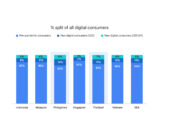Microfinance lending software is a powerful and specialized tool that supports lenders in effectively managing their microfinance operations. With a focus on simplifying the lending process and addressing the specific requirements of borrowers, this software provides a variety of critical features. In this article, we will outline the key features that borrowers should consider when choosing a lending solution.
User-Friendly Interface
According to Forrecter, every $1 invested in UX results in a return of $100. User-friendly microfinance software is essential for several reasons. Firstly, it ensures accessibility, allowing staff with varying technical expertise to efficiently use the software. Secondly, it improves efficiency, streamlining processes and enabling faster adoption by reducing the learning curve. Thirdly, it enhances accuracy by minimizing errors and data entry mistakes. Fourthly, it facilitates training and onboarding of new staff, ensuring continuity in operations and reducing disruptions. Lastly, a user-friendly interface benefits clients, leading to better financial management, higher repayment rates, and increased satisfaction. Overall, such software supports the mission of microfinance institutions in promoting financial inclusion and poverty alleviation.
Borrower Management
Borrower management is a centralized system that allows lenders to store and access all borrower information in one place. Lenders can create borrower profiles, store personal and financial data, and track repayment history. This consolidated data facilitates informed decisions about loan approvals, reduces lending risks, and enables lenders to assess borrowers’ creditworthiness more effectively. Additionally, borrower management enhances communication and engagement between lenders and borrowers, streamlines processes through automation, and ensures compliance with regulatory requirements. Borrower management improves efficiency, data security, and borrower relationships for financial institutions.
Loan Application Processing

image via freepik
Microfinance lending software streamlines the loan application process, enabling borrowers to apply online and automating the review, verification, and approval steps. This automation reduces paperwork, minimizes errors, and expedites loan disbursements. Borrowers benefit from a user-friendly online interface, quick verification of their information, and transparent communication throughout the process. Lenders gain access to advanced credit scoring and risk assessment tools, allowing for efficient loan approvals. The software ensures data security and scalability, accommodating a growing number of borrowers and applications. Additionally, the platform offers valuable analytics and reporting features, empowering lenders to make data-driven decisions and optimize their operations.
Credit Scoring and Risk Assessment
Credit scoring and risk assessment algorithms are utilized by lenders to evaluate borrowers’ creditworthiness. These algorithms analyze factors like credit history, income, and repayment track record to predict the likelihood of loan repayment. The borrower’s debt-to-income ratio, credit utilization, and length of credit history are also considered in the assessment. The algorithms generate a numerical credit score, representing the borrower’s risk level, with higher scores indicating lower risk. Lenders use this information to make well-informed lending decisions and mitigate potential lending risks.
Loan Disbursement and Repayment
Automated loans disbursement and repayment systems streamline the lending process, providing efficiency and convenience for lenders and borrowers. These microfinance systems transfer approved funds directly into borrowers’ accounts, eliminating manual processes and reducing the risk of errors. Automated repayment schedules are generated, ensuring borrowers know when and how much to repay. Reminder notifications help prevent defaults and late payments, enhancing borrower satisfaction and reducing financial risks for lenders. The system’s data security and compliance features protect sensitive information and ensure adherence to regulations. Overall, automated loan functionality improves portfolio management, customer experience, and scalability for lenders.
Reports and Analytics
Microfinance lending software offers comprehensive reports and analytics, providing lenders with valuable insights into the performance of their lending portfolio. Key metrics, such as loan portfolio quality, repayment rates, and profitability, are tracked to facilitate data-driven decision-making. The software aids in risk management by assessing creditworthiness and identifying high-risk loans or borrowers. Additionally, it streamlines processes, enhancing operational efficiency and enabling lenders to focus on strategic initiatives and customer relationships. With financial projections and performance tracking features, lenders can make informed decisions and optimize their lending strategies. Ultimately, the software helps microfinance institutions improve their financial outcomes while ensuring regulatory compliance and meeting customer needs.
Security and Compliance
The software employs robust security measures to safeguard sensitive borrower information. These measures include data encryption, access controls, and regular backups. Data encryption ensures that information is transmitted and stored in a secure, unreadable format. Access controls limit data access to authorized personnel through authentication and role-based access. Regular backups provide data recovery options in case of system failures or data loss. Compliance features assist lenders in adhering to relevant regulations and industry standards.
By combining these security measures, the software aims to prevent data breaches and unauthorized access to borrower information. It prioritizes the safety of data and ensures legal compliance. Nonetheless, no system is entirely invulnerable, so regular security audits and monitoring are essential to identify and address potential vulnerabilities. User education and awareness also contribute to maintaining the overall security posture of the software.
Conclusion
To sum up, microfinance software requires three crucial features for success: scalability and flexibility to accommodate diverse microfinance models and client bases; a user-friendly interface to cater to staff and clients with limited technology literacy in underserved areas; and robust data security and privacy measures to protect sensitive client information and comply with regulations.
The software should be adaptable to the specific needs of each microfinance institution, ensuring it can grow alongside them without major reconfiguration. Additionally, an intuitive interface with clear data presentation and straightforward input mechanisms is essential to enable efficient navigation for users.
Furthermore, data security is paramount, with features like encryption, access controls, and secure data storage to safeguard financial information and build trust with clients. Overall, while other functionalities, such as loan management and accounting, are important, these three core features form the foundation of effective microfinance software that empowers institutions to serve their clients better and foster financial inclusion. Use these insights to select the right solution for your business.
Featured image credit: freepik






